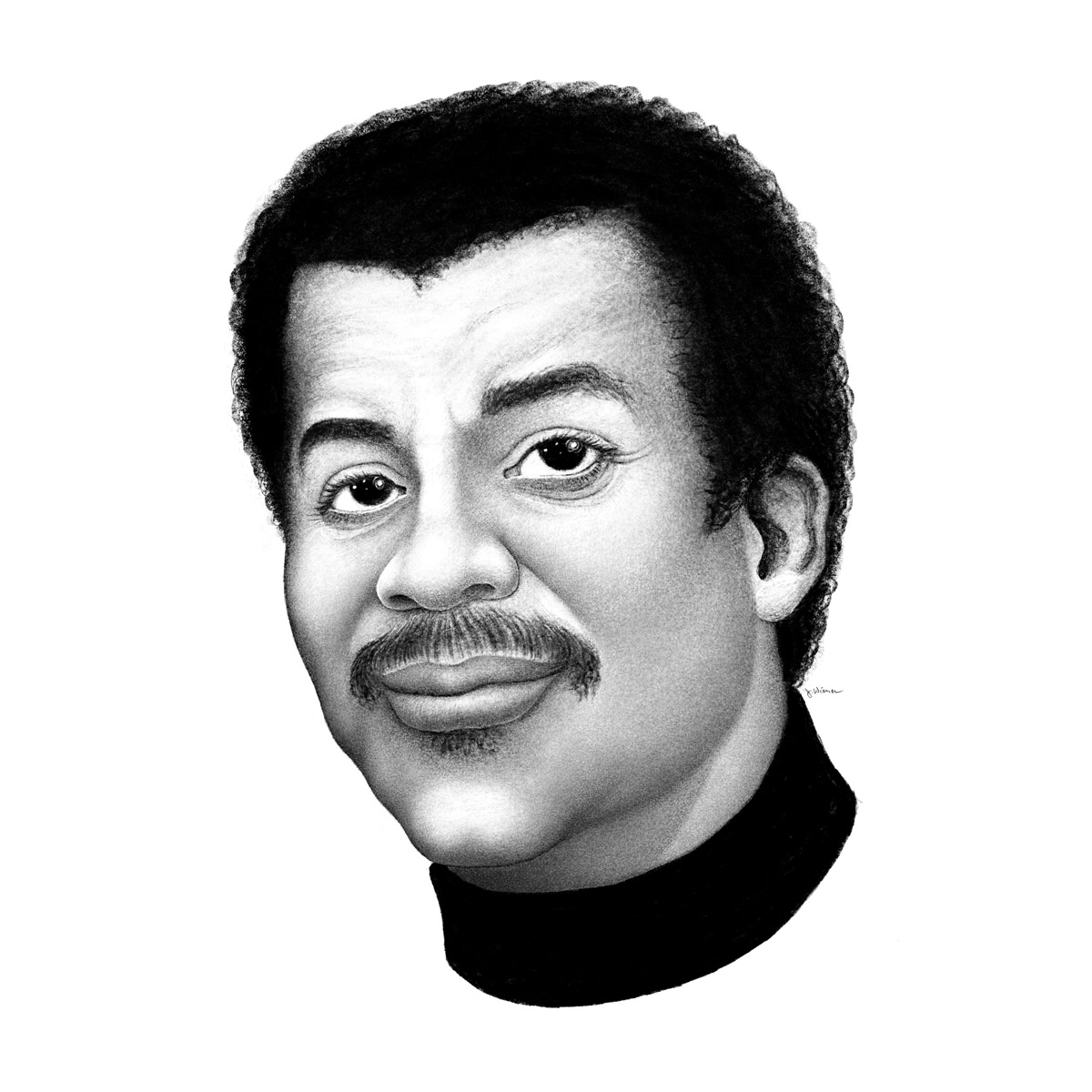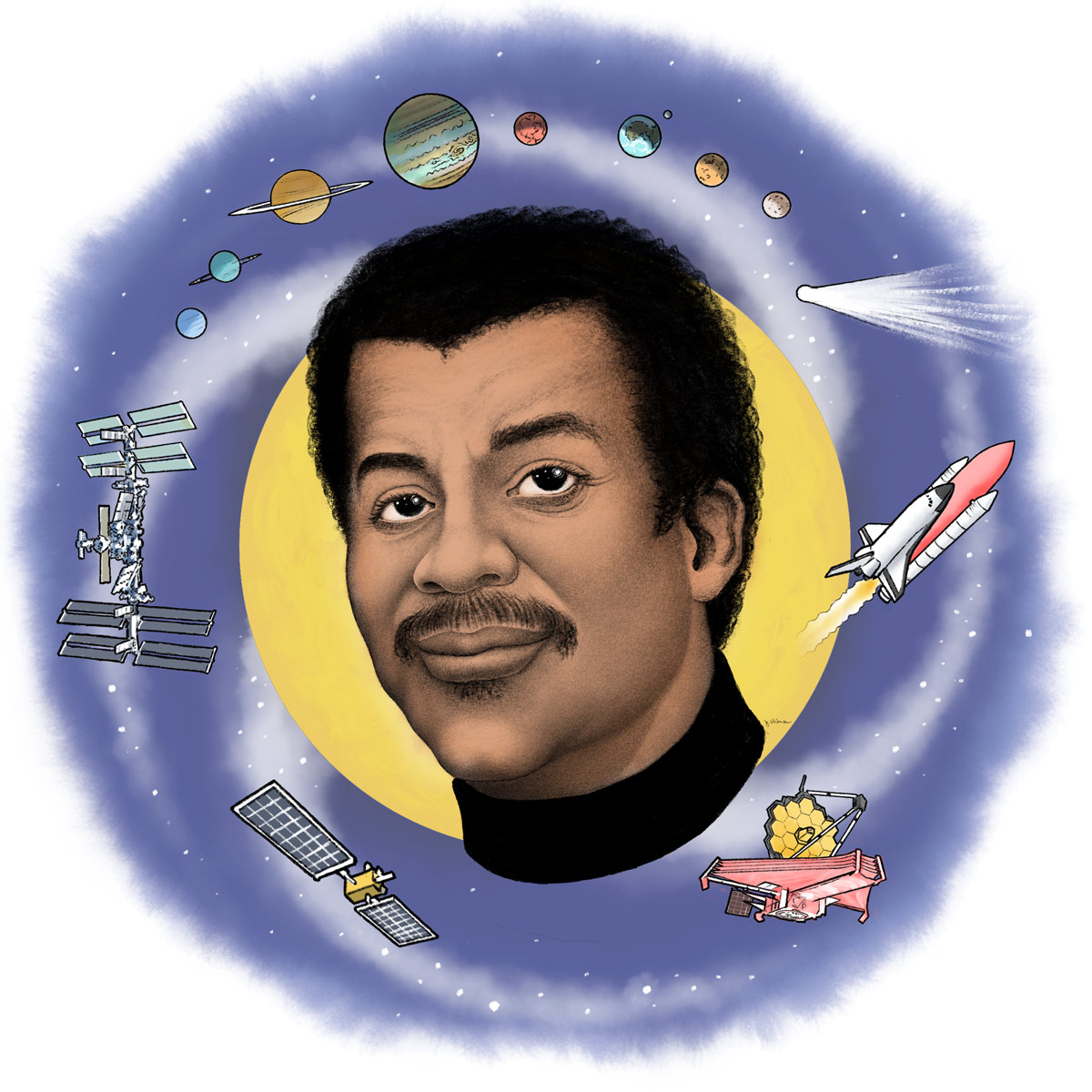
Like a comet that arrives once a decade, a challenging, high-profile assignment tests my metal and pushes me to the outer limits of my skill set.
I realize with glee that have an exciting career, and I never know what’s coming around the corner. This portrait/illustration commission of American astrophysicist, planetary scientist, author, and science communicator Neil deGrasse Tyson came to my studio (Young Mind Interactive) as a last minute opportunity. That’s how it works, sometimes. I had about ten days to develop and produce this illustration, while traveling from New York to Florida and back. Scary? You betcha.
Neil deGrasse Tyson will become an honorary recipient of the Walter Cronkite Award that education non-profit Reach the World awards each year at their annual benefit. Reach the World has been a client of mine for almost 25 years, and we have a bond of trust and understanding over the decades that allows for broad creativity on my part. I’m often asked to jump in and provide a unique design solution when tight situations arrive. In my mind, these situations are opportunities to take creative chances.
I happen to be a huge fan of Neil deGrasse Tyson, and watch him when he’s on any media platform. That can be several times a month for years and years. His face is very familiar to me, as it is for millions of people. Which makes this portrait commission extra challenging. If I get this wrong in any way, lots of people will notice it. And yet, if I get this right, and even better than good, lots of people will love it. I love that high-wire act.
I started this assignment by collecting a dozen iconic photos of Neil’s face from his early days all the way to the present. There is so much to choose from online. He has two expressions I noticed the most: his official portrait, and his face when he is speaking passionately about the topics he loves the most. I wanted to present him as “Timeless” and “Heroic”, like Captain Kirk from the Star Trek series.

Knowing that I would not simply copy a photo of Neil as an outline to draw on top of, I studied his face until knew every crease and detail. I sketched several versions of his face, reworking his jawline three times over a week period, until I found a happy balance between some of his youthful photos and how he looks now, as an older man like myself.
The Sun was simple to create. However, the other objects in space floating around the required some photo research, and tracing in order to pull off. The spiraling Milky Way was rendered freehand with a watercolor wash, as were the rest of those objects. The specific technique uses a lot of layers and erasing away over-painting, then collapsing the layers as I move along and feel solid and committed to the look of it.
I used my iPad and the APP Procreate to draw out the portrait as if I were using my Ebony brand pencils on a textured sheet of paper. Once I was satisfied with the portrait in black and white, I went about working on the elements floating around the portrait, following my approved sketches and layouts for a horizontal and square formats. Then I passed the PSD file BACK to my iPad to continue drawing the space objects. This back-and-forth process can happen several times if I feel the need to switch up the tools I am using and adjust the layouts as per client requests.
Once the iPad drawing/painting was complete, I exported and passed a layered PSD (Photoshop) file over to my computer to make some final adjustments and get preview JPEGS over to the client and Neil’s team for approval. This back-and-forth with a client, when a deadline is tight, and there are way to many eyeballs in the approval process, can be tense and wrought with the possibility for something to go completely off-track.
Everything went without a hitch, with the exception of my own uncertainty mid-way through the drawing, when I realized that I had not gotten some details right, and I erased half the face and started over with a blank white area. I won’t even tell you which half! It’s tough creating a portrait without the subject in front of you AND not being able to copy someone else’s photograph. And of course, NO ARTIFICIAL INTELLIGENCE was required to solve this creative image-making challenge.


